-
Sale!

 The weapon Liu Jing Ru uses to perform is called Yuan Yang Yue, a very special double hook-shaped sabre that can be utilized for defense and health fitness.
The weapon Liu Jing Ru uses to perform is called Yuan Yang Yue, a very special double hook-shaped sabre that can be utilized for defense and health fitness. -
Sale!

 Such VCD presents the martial arts forms by Huang Ming Jian, the Chinese Southern Boxing Competition Championship winner. And his teaching and presentation can help you quickly master the arts from the superficial to the depth.
Such VCD presents the martial arts forms by Huang Ming Jian, the Chinese Southern Boxing Competition Championship winner. And his teaching and presentation can help you quickly master the arts from the superficial to the depth. -
Sale!

 I-Chi Medical Qigong online course chooses 64 pivotal acupoints across human body to activate the flowing of Chi along the main Ren and Du meridians, thus gaining the effect for dredging the channels and cultivating Jing, Qi and Shen for the body.
I-Chi Medical Qigong online course chooses 64 pivotal acupoints across human body to activate the flowing of Chi along the main Ren and Du meridians, thus gaining the effect for dredging the channels and cultivating Jing, Qi and Shen for the body. -
Sale!
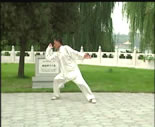
 Ba Gua Zhang is one of three sisters internal Kung Fu styles and the other two is Tai Ji Chuan and Xing Yi Chuan, As with Xing Yi and Tai Ji, the practice of Bagua generates vital energy for both health and combat purposes. Ba Gua Zhang uses palm techniques exclusively but outwardly is simpler in style, which makes it distinct from Xing Yi and Tai Ji styles.
Ba Gua Zhang is one of three sisters internal Kung Fu styles and the other two is Tai Ji Chuan and Xing Yi Chuan, As with Xing Yi and Tai Ji, the practice of Bagua generates vital energy for both health and combat purposes. Ba Gua Zhang uses palm techniques exclusively but outwardly is simpler in style, which makes it distinct from Xing Yi and Tai Ji styles. -
Sale!

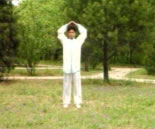 Da Yan Qigong means the Wild Goose Form. This practice consists of 64 movements that flow from one movement into the next. This well known Chinese discipline can reduce stress and anxiety, while improving overall physical fitness, balance, and flexibility. By alleviating tension, they can also combat insomnia and relieve certain types of headache.
Da Yan Qigong means the Wild Goose Form. This practice consists of 64 movements that flow from one movement into the next. This well known Chinese discipline can reduce stress and anxiety, while improving overall physical fitness, balance, and flexibility. By alleviating tension, they can also combat insomnia and relieve certain types of headache. -
Sale!
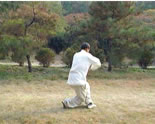
 Such online VCDs present the martial arts forms by Liu Xue Bo and his disciples, the teaching and presentation can help practitioners quickly master the essentials of this special kungfu arts.
Such online VCDs present the martial arts forms by Liu Xue Bo and his disciples, the teaching and presentation can help practitioners quickly master the essentials of this special kungfu arts. -

 Description This painting 仙山楼阁 was made by Chou Ying (1494-1552), Ming Dynasty. He was born in Jiangsu Province. He had a good command of painting characters, flowers and mountains. This painting scroll depicts the pavilion and mountains that are away from noisy human society. Specification Whole painting scroll: width: 55cm, height: 174cm [Author]: Chou Ying, Ming Dynasty [Material]: Painting paper made from rice stalk, silk cloth as background material
Description This painting 仙山楼阁 was made by Chou Ying (1494-1552), Ming Dynasty. He was born in Jiangsu Province. He had a good command of painting characters, flowers and mountains. This painting scroll depicts the pavilion and mountains that are away from noisy human society. Specification Whole painting scroll: width: 55cm, height: 174cm [Author]: Chou Ying, Ming Dynasty [Material]: Painting paper made from rice stalk, silk cloth as background material -

 Description This painting 事铭图 was made by Tang Bohu 唐伯虎 (1470 -1524), Ming Dynasty. He was born in Suzhou, Jiangsu Province. He experienced much ups and downs during his life span. He preferred visiting mountains and historic sites. He made a living by selling his paintings. This painting scroll depicts a hermitage located within rolling mountain ranges. Specification Whole painting scroll: width: 150cm, height: 40cm [Author]: Tang Bohu, Ming Dynasty [Material]: Painting paper made from rice stalk, silk cloth as background material.
Description This painting 事铭图 was made by Tang Bohu 唐伯虎 (1470 -1524), Ming Dynasty. He was born in Suzhou, Jiangsu Province. He experienced much ups and downs during his life span. He preferred visiting mountains and historic sites. He made a living by selling his paintings. This painting scroll depicts a hermitage located within rolling mountain ranges. Specification Whole painting scroll: width: 150cm, height: 40cm [Author]: Tang Bohu, Ming Dynasty [Material]: Painting paper made from rice stalk, silk cloth as background material. -

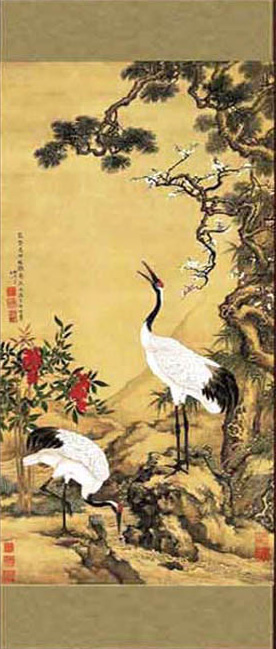 Description This painting 松鹤延年 was made by Shen 沈铨 (1682—1760), who was born in Zhejiang Province. He was skilled in painting animals, girls, birds. This painting scroll tells the hope for the longevity cherished by most people, especially old ones. Specification Whole painting scroll: width: 56cm, height: 140cm Painting size: width: 48cm, height: 93.8cm [Author]: Shen Quan, Qing Dynasty [Material]: Painting paper made from rice stalk, silk cloth as background material
Description This painting 松鹤延年 was made by Shen 沈铨 (1682—1760), who was born in Zhejiang Province. He was skilled in painting animals, girls, birds. This painting scroll tells the hope for the longevity cherished by most people, especially old ones. Specification Whole painting scroll: width: 56cm, height: 140cm Painting size: width: 48cm, height: 93.8cm [Author]: Shen Quan, Qing Dynasty [Material]: Painting paper made from rice stalk, silk cloth as background material -
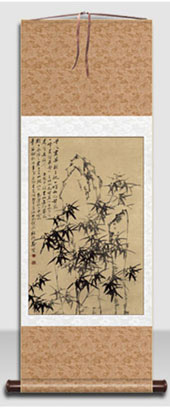
 Description This painting 竹石图 was made by Zhen Banqiao 郑板桥 (1693-1765), Qing Dynasty. He was born in Xinghua, Jiangsu Province. He was skilled in doing fine brushwork to paint orchid, bamboo and stone. This painting scroll depicts bamboo flourishing in their own way in wilds. Specification Whole painting scroll: width: 55cm, height: 165cm Painting size: width: 44cm, height: 71cm [Author]: Zhen Banqiao, Qing Dynasty [Material]: Painting paper made from rice stalk, silk cloth as background material
Description This painting 竹石图 was made by Zhen Banqiao 郑板桥 (1693-1765), Qing Dynasty. He was born in Xinghua, Jiangsu Province. He was skilled in doing fine brushwork to paint orchid, bamboo and stone. This painting scroll depicts bamboo flourishing in their own way in wilds. Specification Whole painting scroll: width: 55cm, height: 165cm Painting size: width: 44cm, height: 71cm [Author]: Zhen Banqiao, Qing Dynasty [Material]: Painting paper made from rice stalk, silk cloth as background material -

 Description Reality-Cultivating Knacks Chart 修真图 is one that illustrating the practical knacks needed for proper practice. Some researchers claim this painting was created based upon the Yellow Court Canon---a very important alchemy practice classics---and it reveals the hidden role for each internal organs and orifices. To better understand Xiu Zhen Tu, people should pay attention upon five aspects: first is orifice, second is five internal organs, the third is in compliance with timing, the fourth is I-Ching application and the last is the relation between them. It is a diagram giving the directions necessary for all practicing steps. This painting, in combination with the Inner Landscape of Human's Body, is a must for all qigong practitioners for further practice Specification Whole painting width: 55cm, height: 168 cm; inner painting: width:45cm, height 73cm scroll painting on cloth (tolerance allowed). English translation of all Chinese poem or essay on the painting is provided for better understanding.
Description Reality-Cultivating Knacks Chart 修真图 is one that illustrating the practical knacks needed for proper practice. Some researchers claim this painting was created based upon the Yellow Court Canon---a very important alchemy practice classics---and it reveals the hidden role for each internal organs and orifices. To better understand Xiu Zhen Tu, people should pay attention upon five aspects: first is orifice, second is five internal organs, the third is in compliance with timing, the fourth is I-Ching application and the last is the relation between them. It is a diagram giving the directions necessary for all practicing steps. This painting, in combination with the Inner Landscape of Human's Body, is a must for all qigong practitioners for further practice Specification Whole painting width: 55cm, height: 168 cm; inner painting: width:45cm, height 73cm scroll painting on cloth (tolerance allowed). English translation of all Chinese poem or essay on the painting is provided for better understanding. -

 Description This painting 白鸟朝凤图 was made by Shen Quan 沈铨 (1693-1765), Qing Dynasty. He was born in Wuxing, Jiangsu Province. He was skilled in doing fine brushwork to paint flowers, birds and characters. This painting scroll depicts many kinds of birds with phoenix as leading role. Specification Whole painting scroll: width: 180cm, height: 45cm Painting size: width: 137cm, height: 34cm [Author]: Shen Quan, Qing Dynasty [Material]: Painting paper made from rice stalk, silk cloth as background material
Description This painting 白鸟朝凤图 was made by Shen Quan 沈铨 (1693-1765), Qing Dynasty. He was born in Wuxing, Jiangsu Province. He was skilled in doing fine brushwork to paint flowers, birds and characters. This painting scroll depicts many kinds of birds with phoenix as leading role. Specification Whole painting scroll: width: 180cm, height: 45cm Painting size: width: 137cm, height: 34cm [Author]: Shen Quan, Qing Dynasty [Material]: Painting paper made from rice stalk, silk cloth as background material -
 Description The painting 彩色内经图, together with the Xiu Zhen Tu 修真图, is very important in Tao pursuing process(internal alchemy practice). Some qigong masters tell their disciples that when they know all the skills they need the two paintings for direction. They mean this one and the Xiu Zhen Tu. Inner Landscape of Human's Body shows practitioners in a very abstract way of all all necessary points in the human's body and their roles they played in the meditation practice. There are lots of poem in Chinese giving hints for the proper practice in relation to different acupoints. It is not easy nowadays to get the painting. The left photo is shot in a bad environment, so it looks not good enough. In fact it is a very eye-catching painting featuring ancient Chinese elements. Specification Whole painting: width: 70cm, height: 170cm Inner painting: width: 60cm, height: 105cm Scroll paining on cloth (tolerance allowed). English translation of all Chinese poem or essay on the painting is provided for better understanding.
Description The painting 彩色内经图, together with the Xiu Zhen Tu 修真图, is very important in Tao pursuing process(internal alchemy practice). Some qigong masters tell their disciples that when they know all the skills they need the two paintings for direction. They mean this one and the Xiu Zhen Tu. Inner Landscape of Human's Body shows practitioners in a very abstract way of all all necessary points in the human's body and their roles they played in the meditation practice. There are lots of poem in Chinese giving hints for the proper practice in relation to different acupoints. It is not easy nowadays to get the painting. The left photo is shot in a bad environment, so it looks not good enough. In fact it is a very eye-catching painting featuring ancient Chinese elements. Specification Whole painting: width: 70cm, height: 170cm Inner painting: width: 60cm, height: 105cm Scroll paining on cloth (tolerance allowed). English translation of all Chinese poem or essay on the painting is provided for better understanding. -
 Description The painting 内经图, together with the Xiu Zhen Tu 修真图, is very important in Tao pursuing process(internal alchemy practice). Some qigong masters tell their disciples that when they know all the skills they need the two paintings for direction. They mean this one and the Xiu Zhen Tu. Inner Landscape of Human's Body shows practitioners in a very abstract way of all all necessary points in the human's body and their roles they played in the meditation practice. There are lots of poem in Chinese giving hints for the proper practice in relation to different acupoints. It is not easy nowadays to get the painting. The left photo is shot in a bad environment, so it looks not good enough. In fact it is a very eye-catching painting featuring ancient Chinese elements. Specification Its width: 60cm, height: 170 cm (tolerance allowed)
Description The painting 内经图, together with the Xiu Zhen Tu 修真图, is very important in Tao pursuing process(internal alchemy practice). Some qigong masters tell their disciples that when they know all the skills they need the two paintings for direction. They mean this one and the Xiu Zhen Tu. Inner Landscape of Human's Body shows practitioners in a very abstract way of all all necessary points in the human's body and their roles they played in the meditation practice. There are lots of poem in Chinese giving hints for the proper practice in relation to different acupoints. It is not easy nowadays to get the painting. The left photo is shot in a bad environment, so it looks not good enough. In fact it is a very eye-catching painting featuring ancient Chinese elements. Specification Its width: 60cm, height: 170 cm (tolerance allowed) -
 Description Reality-Cultivating Knacks Chart 修真图 is one illustrating the practical knacks needed for proper practice. Some researchers claim this painting was created based upon the Yellow Court Canon---a very important alchemy practice classics---and it reveals the hidden role for each internal organs and orifices. To better understand Xiu Zhen Tu, people should pay attention upon five aspects: first is orifice, second is five internal organs, the third is in compliance with timing, the fourth is I-Ching application and the last is the relation between them. It is a diagram giving the directions necessary for all practicing steps. This painting, in combination with the Inner Landscape of Human's Body, is a must for all qigong practitioners for further practice Specifition Whole painting width: 59 cm, height: 157 cm; inner painting: width:51 cm, height 110 cm scroll painting on cloth (tolerance allowed). English translation of all Chinese poem or essay on the painting is provided for better understanding.
Description Reality-Cultivating Knacks Chart 修真图 is one illustrating the practical knacks needed for proper practice. Some researchers claim this painting was created based upon the Yellow Court Canon---a very important alchemy practice classics---and it reveals the hidden role for each internal organs and orifices. To better understand Xiu Zhen Tu, people should pay attention upon five aspects: first is orifice, second is five internal organs, the third is in compliance with timing, the fourth is I-Ching application and the last is the relation between them. It is a diagram giving the directions necessary for all practicing steps. This painting, in combination with the Inner Landscape of Human's Body, is a must for all qigong practitioners for further practice Specifition Whole painting width: 59 cm, height: 157 cm; inner painting: width:51 cm, height 110 cm scroll painting on cloth (tolerance allowed). English translation of all Chinese poem or essay on the painting is provided for better understanding. -

 Description The painting 火候图, together with the Xiu Zhen Tu 修真图 and Nei Jing Tu 内经图, makes up the three "musts" for possession by alchemy practitioners. There are three knacks commonly proclaimed by many alchemy practitioners and one is the firing process secrets. Like to cook a pot of rice, people have to first know what materials are needed, then prepare everything in order, the last is to cook the rice. People have to take a good control of the fire to make sure the fire should not be too strong (the rice may go char)---or should not be too weak (as result, the rice may not ready for eating). Therefore, during most part of the process--transform Jing to Qi, transform Qi to Shen, transform Qi to Shen and bring Shen back to emptiness---alchemy practitioners have to be very careful with the firing process, every now and then. Poem in Chinese gives hints to the main points and under the proper direction practitioners can master the secret. Such painting should be read together with Nei Jing Tu and Xiu Zhen Tu. Specification Its width: 55 cm, height: 178 cm, scroll paining on cloth (tolerance allowed). English translation of all Chinese poem or essay on the painting is provided for better understanding.
Description The painting 火候图, together with the Xiu Zhen Tu 修真图 and Nei Jing Tu 内经图, makes up the three "musts" for possession by alchemy practitioners. There are three knacks commonly proclaimed by many alchemy practitioners and one is the firing process secrets. Like to cook a pot of rice, people have to first know what materials are needed, then prepare everything in order, the last is to cook the rice. People have to take a good control of the fire to make sure the fire should not be too strong (the rice may go char)---or should not be too weak (as result, the rice may not ready for eating). Therefore, during most part of the process--transform Jing to Qi, transform Qi to Shen, transform Qi to Shen and bring Shen back to emptiness---alchemy practitioners have to be very careful with the firing process, every now and then. Poem in Chinese gives hints to the main points and under the proper direction practitioners can master the secret. Such painting should be read together with Nei Jing Tu and Xiu Zhen Tu. Specification Its width: 55 cm, height: 178 cm, scroll paining on cloth (tolerance allowed). English translation of all Chinese poem or essay on the painting is provided for better understanding. -
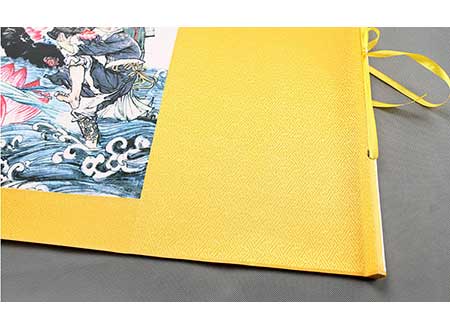
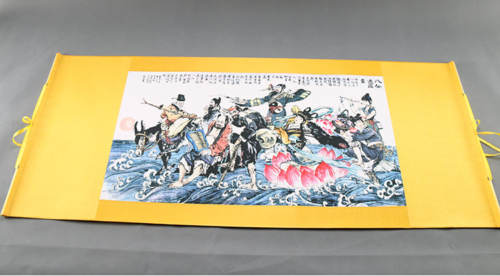 Description This painting 八仙过海 depicts the scene where eight immortals sailing across the ocean in a legendary story. Each of eight immortals has different character and behavior but they are together in sailing across the ocean of delusion Specification Height: 55cm, width: 127 cm (tolerance allowed)
Description This painting 八仙过海 depicts the scene where eight immortals sailing across the ocean in a legendary story. Each of eight immortals has different character and behavior but they are together in sailing across the ocean of delusion Specification Height: 55cm, width: 127 cm (tolerance allowed) -

 Description The painting's 听琴图 background was handled very concisely. Behind the protagonist is a tree, with luxuriant longissima clinging. Under the pine tree are a number of bamboo culm, verdant, swaying. In addition to piano case, only a few incense burning on the incense burner. Opposite to protagonist is a small and exquisite stone on which stands a small tripod, with the flower shoots within. This painting make people feel that this is a high level park, carefully tailored by the painter. All sets as well as the position of the minor characters are arranged around the protagonist's performance. The of the whole picture makes people feel the atmosphere in the stillness, and get on the bursts of sound of the piano, together with the sound of the breeze stirred the pine leaves. A poem from Bai Juyi can well describe the beaut: "the sound of silence.". Specification Whole painting: width: 45cm, height: 182cm [Author]: Zhao Ji, Northern Song Dynasty, [Material]: painting paper made from from rice stalk, silk cloth as background material Click HERE for more pictures
Description The painting's 听琴图 background was handled very concisely. Behind the protagonist is a tree, with luxuriant longissima clinging. Under the pine tree are a number of bamboo culm, verdant, swaying. In addition to piano case, only a few incense burning on the incense burner. Opposite to protagonist is a small and exquisite stone on which stands a small tripod, with the flower shoots within. This painting make people feel that this is a high level park, carefully tailored by the painter. All sets as well as the position of the minor characters are arranged around the protagonist's performance. The of the whole picture makes people feel the atmosphere in the stillness, and get on the bursts of sound of the piano, together with the sound of the breeze stirred the pine leaves. A poem from Bai Juyi can well describe the beaut: "the sound of silence.". Specification Whole painting: width: 45cm, height: 182cm [Author]: Zhao Ji, Northern Song Dynasty, [Material]: painting paper made from from rice stalk, silk cloth as background material Click HERE for more pictures -

 Description Tang Yin painted a straw yard. An old man sitting on a mat, wearing a towel, dressed in loose robes, hugging his knees to look up at the sky, like singing or sighing, with calm expression. Indoor is frugal, censer and stationery table shows the author's identity and interests. Behind is bamboo fence, in accompany with trees in variety. The painting 唔子养性图 features comfort, easiness, figures’ expression well compatible with environment. . Specification Author: Ming Tang Yin. Size: height: 40cm / width: 145cm Material: painting paper made from rice stalk, silk cloth as background material Source: From Liaoning Museum Size: Height: 40 cm, width: 145 cm,
Description Tang Yin painted a straw yard. An old man sitting on a mat, wearing a towel, dressed in loose robes, hugging his knees to look up at the sky, like singing or sighing, with calm expression. Indoor is frugal, censer and stationery table shows the author's identity and interests. Behind is bamboo fence, in accompany with trees in variety. The painting 唔子养性图 features comfort, easiness, figures’ expression well compatible with environment. . Specification Author: Ming Tang Yin. Size: height: 40cm / width: 145cm Material: painting paper made from rice stalk, silk cloth as background material Source: From Liaoning Museum Size: Height: 40 cm, width: 145 cm, -
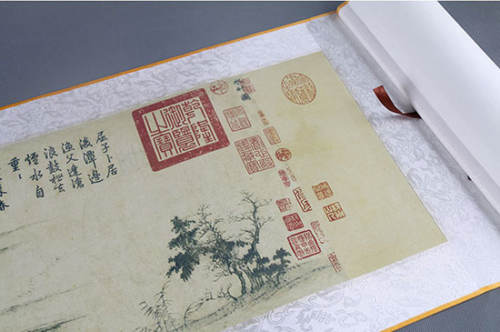
 Description "Village Surrounded By Water" 山村图 is a picture of a long scroll with ink landscape, depicting a friend settled down in seclusion with quiet scenery. Specification Author: Zhao Mengtiao, Yuan Dynasty Size: Height: 34cm / Width: 180cm Material: Core painting paper made from rice stalk, silk cloth as background material Production: hand work.
Description "Village Surrounded By Water" 山村图 is a picture of a long scroll with ink landscape, depicting a friend settled down in seclusion with quiet scenery. Specification Author: Zhao Mengtiao, Yuan Dynasty Size: Height: 34cm / Width: 180cm Material: Core painting paper made from rice stalk, silk cloth as background material Production: hand work. -
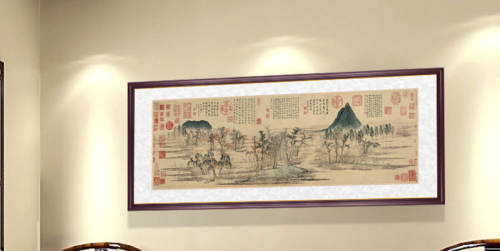
 Description The painting 鹊华秋色 scroll features autumn mountains in Qi State where magpie dwells. On the painting scroll people can find reeds, looming fishermans houses. Under thick leaves shade people can behold two steep mountain, opposite in distance. The authors used freehand brushwork to paint rocks and trees as well as mountains with fine and soft cascading layers, and using light color to ink moist and thawing effect. . Specification [Author]: Zhao Mengtiao, Yuan Dynasty [Size]: height: 40 Width: 140 cm [Material]: paper made from rice stalk, silk cloth as background material [Production]: hand work [Source] Taipei Museum of the Imperial Palace .
Description The painting 鹊华秋色 scroll features autumn mountains in Qi State where magpie dwells. On the painting scroll people can find reeds, looming fishermans houses. Under thick leaves shade people can behold two steep mountain, opposite in distance. The authors used freehand brushwork to paint rocks and trees as well as mountains with fine and soft cascading layers, and using light color to ink moist and thawing effect. . Specification [Author]: Zhao Mengtiao, Yuan Dynasty [Size]: height: 40 Width: 140 cm [Material]: paper made from rice stalk, silk cloth as background material [Production]: hand work [Source] Taipei Museum of the Imperial Palace . -

 Description Damour or Dharma is a famou Buddhism figure 达摩神悟图. Author Introduction Fan Zeng 1938.7.5-, born in Nantong, Jiangsu province, China contemporary scholar, thinker, master in Chinese calligraphy, painting, poem and literature. Now serves as director of Chinese Painting Research Institute at Peking University, lifelong China Art Research Institute researcher, Nankai University, an honorary doctor of literature, with the honorary degree of doctor of literature, University of Alberta. He has published more than 160 poem together with calligraphy and painting, philosophical writings. . Specification Name: Damour in Chan Meditation Author: Fan Ceng. Size: width: 55 cm / height: 162cm Material: core painting paper made from rice stalk, silk cloth as background material Production: hand work
Description Damour or Dharma is a famou Buddhism figure 达摩神悟图. Author Introduction Fan Zeng 1938.7.5-, born in Nantong, Jiangsu province, China contemporary scholar, thinker, master in Chinese calligraphy, painting, poem and literature. Now serves as director of Chinese Painting Research Institute at Peking University, lifelong China Art Research Institute researcher, Nankai University, an honorary doctor of literature, with the honorary degree of doctor of literature, University of Alberta. He has published more than 160 poem together with calligraphy and painting, philosophical writings. . Specification Name: Damour in Chan Meditation Author: Fan Ceng. Size: width: 55 cm / height: 162cm Material: core painting paper made from rice stalk, silk cloth as background material Production: hand work -

 Description This painting 秋山渔隐图轴 describes doing fishing in retreat places where no people frequent. Author Introduction Lan Ying 蓝瑛 (1585-1664), one of the painters in Ming Dynasty (1585- about 1666). Born in Qian Tang (now Hangzhou Zhejiang). The representative painter among Zhejiang school of artists in Ming Dynasty. He was good at painting landscape, flowers and birds, plum.. Specification [Author] Lan Ying, Ming Dynasty. [Size] Core painting area: 44x132cm / Whole size: 55x205cm [Material] Core painting paper made from rice stalk, silk cloth as background material [Production]: hand work [Source]: Tianjin Museum .
Description This painting 秋山渔隐图轴 describes doing fishing in retreat places where no people frequent. Author Introduction Lan Ying 蓝瑛 (1585-1664), one of the painters in Ming Dynasty (1585- about 1666). Born in Qian Tang (now Hangzhou Zhejiang). The representative painter among Zhejiang school of artists in Ming Dynasty. He was good at painting landscape, flowers and birds, plum.. Specification [Author] Lan Ying, Ming Dynasty. [Size] Core painting area: 44x132cm / Whole size: 55x205cm [Material] Core painting paper made from rice stalk, silk cloth as background material [Production]: hand work [Source]: Tianjin Museum .



